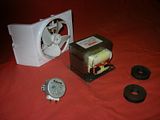
Click the images to enlarge
Micro Wave ovens are a source of treasures for the tinkerer.
Here you can see the Microwave Oven Transformer (MOT), the turntable motor, a cool cooling fan, and two powerful magnets removed from the magnetron.
Before removing anything please short out the high voltage capacitor to eliminate the possibility of electric shock. Just touch both terminals with a screwdriver, while holding the insulated handle.
It's the transformer we'll be focusing on to build our spot welder.
WARNING
Familiarise yourself with transformer theory before embarking on this project. A two transformer welder produces around 400 A. It heats metal to melting point.
IT BITES

The following link is a good place to start.
Very minimal Transformer theory
MOT's can be as high as 1.5KVA.
Enough Tech Talk and Pep Talk, let's get on with it, shall we!!!
| This is what we're talking about, the Microwave Oven Transformer, or MOT as it's affectionately known. Microwave oven transformers are rated according to the size of the oven, usually around 750 to 1200Watts. If building a two transformer welder, ensure you have 2 matching transformers. |
| First we need to remove the SECONDARY winding. An MOT is a
STEP-UP transformer, so the secondary will have more windings and much thinner
wire than the
primary. MOT's generate around 2000 volts
(before we modify them).
Take care NOT to cause any damage to the primary. |
| Once we've cut through the secondary coil, taking care to NOT cause any damage to the primary, we can remove the Magnetron coil (a few turns of a thicker wire). Do not remove the shunts from the core. |
| Now, with the transformer securely mounted, drive the secondary coil from the core. I used a bolt, which fitted in the slot, and had a large enough surface to push the wires out, almost en block. |
Here is the transformer, ready to be "TRANSFORMED" into a welder transformer.
| I used 4 gauge welding wire. Three complete turns gives around 3.5 V. We should be aiming for 3-4 V. |
With the Microwave oven transformer now a welder transformer, it was mounted on a piece of 2 x 6. The primary was wired from the mains, through a light switch. It will eventually have a 0-10 sec, one-shot timer in series with a pushbutton. This must happen soon, because getting the weld time right every time is not easy.
I inserted 1/2" copper pipe into PVC conduit, and fitted it to a hinge system. The 1/4" weld electrodes were fitted to the flattened conduit using cable clamps.
I had a spot welder...
BUT...
I could weld 1/8" stainless rod, at right angles, which meant the contact point, was at a minimum, so the resulting resistance was at max. When I tried to weld any more than that, all I got was a lot of heat, but not enough to melt the steel and form a weld nugget. Even the same 1/8" SS rod, now parallel, was not going to happen with this baby as it was. The above pictures were taken after this attempt, as can be seen by the discoloration of the electrodes.
Back on the scrounge, I found another Microwave oven... Heh, heh!
Another MOT, another motor, another fan, and 2 more "Mooby Big" magnets. Oh, the joy!!!
Yes, I'm a tinkerer.
The new MOT was transformed, I got some 1" Aluminium rod for the weld arms, which was also installed into some PVC conduit, and 1/2" copper for the electrodes.
| The two transformers are joined together, and the primaries
are wired in parallel across the 120 VAC. Check for the 3.5 V across the
electrodes. The transformers must be in phase. If not you'll get 0V. Swap
the leads to one of the primaries, and you're in business.
Please take every precaution to avoid injury. |
| A strategically placed "Toggle Clamp" which presses on a rubber block supplies sufficient pressure to weld. This has the added advantage of holding the material, allowing the weld to happen without having to hold it, thus eliminating fear of burns and electrocution. |
|
Now we have a spot welder! |

|